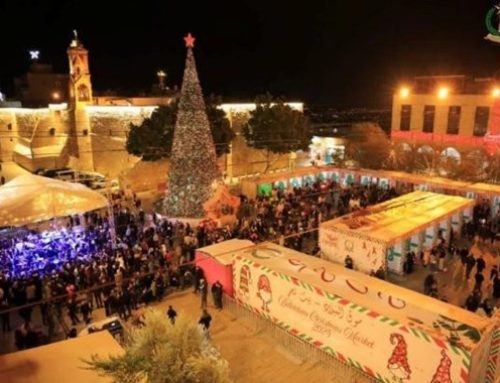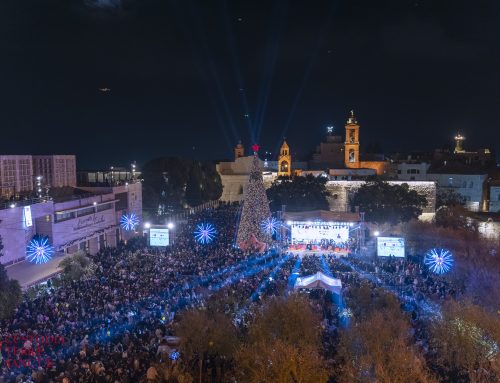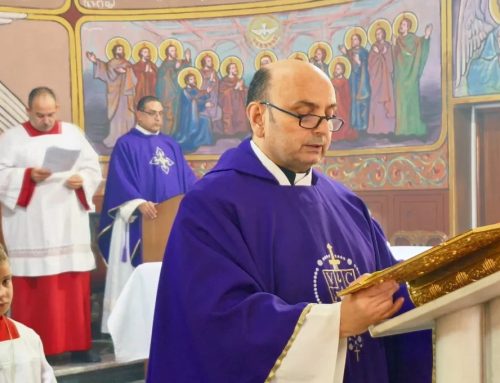The population of Aida camp, north of Bethlehem, is approximately of 5000 people, including 14 Christian families. This camp is an example of solidarity and fraternal coexistence between Muslims and Christians. The Holy Father attaches great importance to the visit that he will pay to Aida during his pilgrimage to the Holy Land. He wants to make it a strong sign for the promotion of peace, dignity and solidarity within and between people, for the good of the whole region. Hind Shraydeh, from the Latin Patriarchate, visited Aida and gives her impressions on the atmosphere that reigns there less than three weeks before the arrival of Pope Benedict XVI.
LPJ.org
At the camp
Arriving at Aida refugee camp on Bethlehem’s north side, one finds oneself in an unruly and hot place, within alleys that give off the sweet smell of thyme and fresh bread, provoking deep emotions. The houses of the camp, built of mud and lined up like domino pieces, give one the sense of a familial environment. Children playing in the alleys are moved by a great dream symbolized by the huge “return key” seen on the outskirts of the camp. The key, weighing two tons and standing ten meters high, is considered a symbol that embodies the dream of return.
The population of the camp is about 5000 with 14 Christian families, which says something about the Christian-Muslim coexistence there. Walking around the outskirts of the camp one is amazed by the high level of education among its citizens, at least judging by the quality of the wall drawings of evacuated Palestinian villages. The portraits and slogans on the walls represent the established Palestinian right of return. They give the impression of a slide show drawing you further in until you reach the center of the camp, and already you begin to feel a belonging to this camp, and by extension to the other 59 camps in Palestine and abroad.
The UNICEF schoolyard is the only playground for the children of the camp. Standing across the street one is attracted by the calls of the children, feeling anticipation when they form two teams.
The citizens of the camp have not shut themselves up in hard-shelled isolation. Despite the cold, harsh memories and the forced immigration, their determination for life gives them new energy every day. They plod on, relying on God to ease the harshness of these years away from their home villages.
Preparatory Committee for the Pope’s Visit
Preparations for Pope Benedict XVI started soon after the official announcement of his Holiness’ visit to the Aida Camp.
The Apostolic Nuncio, Monsignor Antonio Franco, described the papal visit to the region as “a pilgrimage, not a political undertaking”, though “it might support peace, understanding and collaboration for the sake of good will in this land”.
The many preparatory meetings for the visit reflect the extent of the Palestinian public’s interest in the Pope’s visit to the camp, and the official Palestinian interest and that of the Church match it. The inhabitants of the camp, together with its institutions and leaders, are moving forward with the preparations for His Holiness May 13th visit that will last for only one hour. The visit wants to say that the unjust forced immigration has to end.
President Mahmoud Abbas expressed his support for the visit when he declared: “The Palestinian Authority and people welcome the important visit of His Holiness, hoping that the visit will leave an imprint of benevolence, love, and peace in the Land of Peace”. President Abbas set up a committee for organizing and preparing for the visit. The members of the comitee are: Mr. Ziyad Al Bandak, the president of Local Government, Father Majdi Syriani, nominated by the Vatican and the local Church, and the representatives of local institutions at Aida camp, among them Dr. Issa Qaraqe’, a member of the Palestinian Legisltative Council. In addition, the committee consists of representatives of the local service institutions such as the Social Center for Youth, the Refugee Center, representatives from Fatah and the “Ruwad” Center.
Father Majdi Syriani is the link between the Latin Patriarchate and the Palestinian Authority. He mentioned how His Holiness represents more than one billion Christians and how the mere fact of his entering the camp highlights the suffering of its inhabitants. Thus, he hopes, the visit will help bring the suffering of the refugees to the hearts and minds of the world and create a will to end it through achieving justice in Palestine. Father Syriani explained that the world media accompanying His Holiness will help communicate the suffering and show the refugees’ real life.
Father Syriani said that the visit of his Holiness to Palestine and Israel is important and historical. He also talked about what it means for the camp itself, for it will give them the chance to show the facts about Palestinian suffering in their own words. He points out that the visit demonstrates the Vatican’s support for the Palestinian Cause in its various dimensions. Father Syriani added that through this visit, the Pope, who is the head of Catholic Church, recognizes the rights of the Palestinian people, taking the camp as a symbol for those rights, especially in reference with United Nations Resolution 194, issued in December of 1948, which states the refugees’ right of return.
Father Syriani pointed out that the Pope will pass through the center of the Camp, right up against the Separating Wall. He explained that His Holiness knows well the suffering of the Palestinians, because he is originally German and knows first hand what a separating wall is; he was referring to the Wall of Berlin that divided the people and land of Germany for more than 30 years. Thus, his visit to the camp he will give hope to the inhabitants that their darkness will come to an end, and that the wall will collapse when peace finally comes upon this land through effective negotiations that preserve Palestinian rights.
In this regard, the minister of tourism Mrs. Khulud D’iebes said that this visit is not the first of its kind, in terms of relations with the Vatican state, referring to the previous visits by former Popes to the Holy Land, and especially the visit of his Holiness the late Pope John Paul II to Al-Dihasheh camp. Mrs. D’iebes stressed that this visit has a religious importance as well as political message for the whole region, as it brings hope and a promise for the future to the inhabitants living in the camp. She concluded saying that the visit would reinforce the Palestinian case and identity, affirming their cause for independence and spreading the values of justice, equality, freedom, and peace.
Mrs. D’iebes confirmed that the Vatican’s support and help towards the Palestinian refugees has never ceased, nor has its insistence on the Palestinian right of return. She described the real image of the lives of the Palestinians, their struggle under the brutal actions and physiological pressure that the Israelis apply against the Palestinians, whether through checkpoints or the apartheid wall, all these actions being part and parcel of an organized strategic plan aiming at destroying the structure of Palestinian society.
On the other hand, the Parliament member Mr. Issa Qaraqe’ said that the visit of His Holiness to the camp is indeed a significant political event, and has many social, political aspects: including the affirmation of the suffering of the Palestinians, the human dignity of the Palestinian individual, his or her right to live in a normal community and the right of return for all the refugees. This is especially symbolized by the fact that the visit falls so close to the marking of the 61st anniversary of Al-Nakba, or ‘the catastrophe.’ The context demonstrates the unity of the Islamic and Christian parties, how they are all one nation.
Mr. Qaraqe’ added that the importance of this visit lies in presenting the Pope’s vision of the Palestinian case, despite the fact that the Israeli and international media seem to be cooperating in presenting the Israeli case and largely ignoring the suffering of the Palestinian people. Mr. Qaraqe’ added: “The visit of His Holiness to Aida camp means a visit to the whole of Palestinian society, letting the Pope can see how the Palestinians are living. While there he will be able to take in the impact of the wall, the watchtowers and the military zones. This visit will reflect the pain and despair of the Palestinian people, who are seeking freedom, independence and an end to the occupation. This important visit will be a sign of the Palestinian determination that is a fruit of their Arab culture.” This refers to both Muslims and Christians who lived together amicably, facing side by side for years the challenges of war and injustice in this land.
Preparations for the Visit
Mr. Qaraqe’ explained the schedule of the visit, underlining that all the planned activities were approved by the people in charge.
The children of the camp will welcome his Holiness on both sides of the streets, shouting out expressions of welcome of both a social and national nature. Wall posters, welcoming banners and both Palestinian and Vatican flags will also line the route to welcome His Holiness.
The celebration will start next to the Separating Wall on a platform constructed by the people of the camp. The media will be there to cover the event. The program will take an hour. A photo gallery about Al-Nakba and the different phases of the refugees’ history will be set up for people to browse. President Mahmoud Abbas will start the celebration with a speech followed by a speech by His Holiness. Some of the camp’s citizens will speak after that and at the end there will be two artistic presentations.
The inhabitants of the camp will present His Holiness with two gifts: the first is a necklace with a key that symbolizes both the key of the Office of the Pope, referring to the first Pope’s official title as “Keeper of the Keys,” and the key of return; the second gift is a map of Palestine carved into a stone from the Sea of Galilee.
The Vatican declarations on refugees and the Palestinian Question
In a speech by His Holiness to the diplomats assigned by the Apostolic See, Pope Benedict declared: “We cannot be silent when faced with images of immigration camps in numerous places in the world, of people forced into terrible situations in order to avoid even more terrible circumstances, leaving them in need of everything. Aren’t those our brothers and sisters? Haven’t their children come into the world like others, with a legitimate claim to happiness?”
Speaking of Palestinian refugees, Archbishop Celestino Migliore, the International Observer for the Apostolic See to the United Nations, expressed his hope that many problems in the region could be solved through negotiations. He also insisted that any solution should include Jerusalem and condemned the obstacle to freedom of movement presented by the Separation Wall. He insisted on the right of Palestinians from all religions to visit the Holy Places without impediment.
The visit of Pope John Paul II to Al-Dihasheh refugee camp in year 2000
In his visit in the year 2000, Pope John Paul II pointed to the Palestinian sufferings and said: “No one can ignore what the Palestinians have been through in the last decades: it is there for the whole world to see and has gone on too long.”
In addition to that, His Holiness talked about the role of the Vatican and its efforts on behalf of the Palestinians. He said: “The Apostolate Delegate to the region constantly makes it known that the Palestinian people have a right to their own State and the right to live in peace and tranquility with the other people in the region.” He stressed that the Apostolic Delegate spares no effort to urge continued dialogue in order to bring that about.
His Holiness John Paul II said: “All of us should continue the work and pray that we take advantage of every opportunity for peace to prevail on the whole earth. The Palestinian dreams will be realized through a just and lasting peace, a peace reached through real dialogue.”
His Holiness called for the implementation and adherence in full to international law and the UN resolutions which call for Palestinian national autonomy, the right of return and the withdrawal of Israeli forces, including settlements, from Palestinian territories occupied in 1967, namely Gaza, East Jerusalem and the West Bank.
His Holiness John Paul II always encouraged the Palestinians – both Christian and Muslim – to pray for those who have no shelter and no social position and who are struggling to put bread on the table day by day. He said: “On the occasion of my visit today to the camp, hope urges me to sound the alarm telling the international community that there is need to take serious steps to improve the status of the Palestinian people.”





